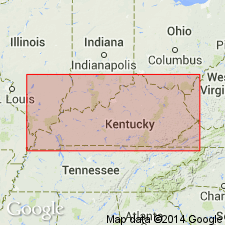
- Usage in publication:
-
- Coal Cliff member
- Modifications:
-
- Informally named
- Dominant lithology:
-
- Shale
- Siltstone
- AAPG geologic province:
-
- Appalachian basin
Summary:
Breathitt Formation is informally elevated to group rank and subdivided into the following eight informal formations: Pocahontas, Bottom Creek, Alvy Creek, Grundy, Pikeville, Hyden, Four Corners, and Princess formations. Coal Cliff member of Alvy Creek formation of Breathitt group is here informally named in Wayne Co., eastern KY. At the type section at Coal Cliff, the lower part of the unit consists of 0 to 8 ft of calcareous sandstone with marine fossil debris, while the upper part of the unit is 60 to 70 ft of silty shale and siltstone. Shale contains abundant siderite nodules, marine fossils, and burrows. Siltstone is laminated, with no observed fossils or nodules. Unit disconformably underlies the informal Rockcastle Sandstone member of the Lee Formation and overlies the Stearns No. 2 coal bed. Member is recognized in several places along the Lower Pennsylvanian western outcrop belt. Unit together with shale member A is probably laterally equivalent to the Hensley Member of the Alvy Creek formation. [Revisions made in this paper are strongly contested by C. Rice and other USGS scientists who work in this area (oral commun., 9/3/93).]
Source: GNU records (USGS DDS-6; Reston GNULEX).
For more information, please contact Nancy Stamm, Geologic Names Committee Secretary.
Asterisk (*) indicates published by U.S. Geological Survey authors.
"No current usage" (†) implies that a name has been abandoned or has fallen into disuse. Former usage and, if known, replacement name given in parentheses ( ).
Slash (/) indicates name conflicts with nomenclatural guidelines (CSN, 1933; ACSN, 1961, 1970; NACSN, 1983, 2005, 2021). May be explained within brackets ([ ]).

